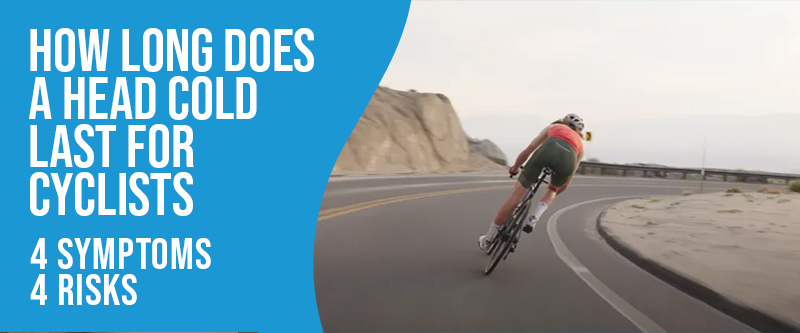A cold is triggered by a virus that affects the nose and throat, quickly spreading to others. It typically transmits through airborne droplets released by the sick person through coughs or sneezes, breathed in by another person.
A head cold lasts normally around 1 to 2 weeks for cyclists. It’s crucial to prioritize rest and not to depress the immune system through intense training when fighting a cold, as this could prolong the infection. Consider certain supplements proven to lessen the duration and severity of symptoms.
This blog post will explore the symptoms, typical duration, and risks associated with head colds in cyclists. Additionally, it will offer valuable treatment suggestions for effectively managing a head cold while cycling.
How Long Does A Head Cold Last For Cyclists: 4 Key Signs

A cyclist’s training program cannot be effective if he or she does not understand the causes, symptoms, and duration of a head cold. By recognizing early signs and adjusting training schedules, cyclists can ensure a quicker return to optimal health and performance.
Typical Symptoms of a Head Cold
Riding a bike while battling a head cold can pose challenges. Evaluating your symptoms’ intensity before hitting the road is crucial. When dealing with a head cold, you may encounter various typical symptoms:
- Congestion: A stuffy or blocked nose can make breathing hard. As long as it’s not too severe, you might still cycle.
- Sore Throat: Your throat may feel scratchy or painful. A mild sore throat without other severe symptoms is usually manageable.
- Runny Nose: You might need to blow your nose often because of excess mucus. If your nose is running but you feel okay, riding might be acceptable.
- Cough: You could have a dry cough or one that produces mucus.
What Is The Average Duration Of A Head Cold?
A head cold usually lasts between 7 to 10 days. Here’s a breakdown of how it typically progresses:
- Days 1-2: Symptoms start with a sore throat and mild congestion.
- Days 3-4: Congestion worsens, and you may develop a runny nose.
- Days 5-7: Symptoms peak. You might feel the most discomfort during these days.
- Days 8-10: Symptoms improve, but a mild cough or congestion might linger.
Understanding these symptoms and their duration can help cyclists manage their training and know when to rest.
When to Consider Resting?

Sometimes, take a break from cycling. Watch for these more severe symptoms:
- Flu-like Conditions: If you’re feeling very sick or exhausted, it’s best to rest and take a few days off from cycling to
give your body time to fight the cold. - Fever: If you have a fever, you are fighting an infection, and physical activity could worsen it.
- Body Aches: If you have widespread aches and pains, it’s a sign that your body needs rest.
Knowing when to engage in physical activity, such as cycling, and when to prioritize rest and recovery will help maintain optimal performance and prevent injuries.
Head Colds and Cycling: 4 Risks
Cycling while you have a head cold can be risky. Understanding these risks is important to making the best decision for your health.
Potential for Prolonged Recovery
If you cycle with severe symptoms, your recovery might take longer. Here’s why:
- Strain on the Body: Physical activity stresses your body, slowing healing.
- Worsening Symptoms: Pushing yourself too hard can worsen your symptoms and extend the duration of your cold.
Complications & Secondary Infections
Riding while sick can also lead to more serious health problems:
- Secondary Infections: Your immune system is already busy fighting the cold. Exercise can weaken it further, making you more prone to infections like sinusitis or bronchitis.
- Complications: Intense physical activity can increase the risk of complications like pneumonia or heart issues.
Treat for Managing Head Cold as a Cyclist: Tips
Dealing with a head cold can be challenging for cyclists. Here are some tips to help manage your symptoms and support your recovery:
Maintaining Hydration & Proper Nutrition

Boost your health with these priceless tips on hydration and nutrition. Master the art of staying well-hydrated and well-fed to reach your peak performance.
- Stay Hydrated: Consuming ample water, herbal teas, and clear broths nourishes your body.
- Eat Nutritious Foods: For a strong immune system, consume foods rich in minerals and vitamins, such as fruits, vegetables, and lean proteins.
- Sleep: Aim for at least 6-8 hours each night to help your body recover and stay healthy.
Intensity Adjustment Based on Symptoms
Tailoring training intensity according to the severity of symptoms can optimize performance and well-being. Fine-tuning your workout levels can also improve your training outcomes.
- Scale Back: If you feel up to cycling, shorten your rides and reduce their intensity.
- Monitor Symptoms: If symptoms worsen, stop cycling and rest until you feel better.
Use of Supplements and Vitamins to Boost Immunity
Look at how these vital nutrients can boost your health. Stay proactive in your wellness journey by choosing the right supplements and vitamins for a robust immune system.
- Vitamin C and Zinc: These can help shorten the duration of a cold and reduce symptom severity.
- Probiotics: Taking probiotics can support gut health and overall immunity. Use decongestants or saline nasal sprays to relieve nasal congestion and maintain easier breathing.
- Hygiene: Wash your hands regularly, avoid touching your face, and steer clear of sick people.
- Consult a doctor: Before starting any supplements, ask your doctor if they are appropriate.
Start by engaging in gentle exercises or short rides to gauge your body’s reaction. Monitor for any return of symptoms or fatigue. If you observe these signs, consider taking another day off or scaling back the intensity. Gradually boost your ride’s length and vigor as your stamina and resilience progress.
Conclusion
As a cyclist, prioritizing your body’s signals is paramount, especially when feeling unwell. Overexerting yourself with a head cold can prolong recovery and heighten the risk of complications.
If symptoms persist or worsen, seeking medical guidance is vital. Remember, a brief pause for healing doesn’t equate to a setback in your training. Prioritize your health today for more substantial rides tomorrow.
FAQs
Will Benadryl Help A Head Cold?
Beyond allergies, antihistamines like allergy relief can temporarily ease runny noses and sneezing linked to colds. If you experience nasal congestion during a cold, consider using Diphenhydramine Allergy Plus Congestion for relief.


